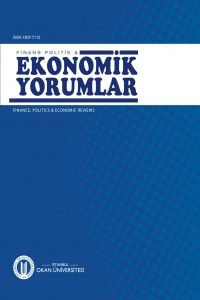Türkiye’de Kadın İşgücü, Eğitim ve Büyüme İlişkisinin VAR Analizi
Toplumsal cinsiyet eşitsizliği ekonomik, sosyal ve siyasal alanda farklı boyutlarıyla kendini göstermektedir. Bilindiği gibi beşeri sermaye ekonomik büyüme ve kalkınmada en az fiziksel sermaye kadar önemlidir. Ne yazık ki beşeri sermayenin en önemli unsurlarından biri olan eğitime ulaşmada da bir cinsiyet eşitsizliği olduğu bilinmektedir. Özellikle kadınların işgücüne katılımlarını ve verimliliklerini, dolayısıyla iktisadi büyümeye olan katkılarını belirlemede eğitim ve eğitimde cinsiyet eşitsizlikleri önemli rol oynamaktadır. Eğitim düzeyi işgücüne katılımın belirleyicilerinden biridir. Eğitim düzeyi yükseldikçe işgücüne katılım artmaktadır. Eğitim yatırımlarının getirisini araştıran pek çok çalışmaya göre, eğitim düzeyi yükseldikçe eğitimin getirisi de artmaktadır. Eğitim kadınların ücretlerini yükselten ve böylece eğitim-ücret-fırsat maliyeti hesaplaması yaptıklarında dışarıda çalışmayı evde kalmaya tercih etmelerine neden olan bir faktördür. Kadın ve erkek arasında ekonomik eşitlik sağlandıkça yoksulluğun azaldığı, GSMH’nın ise arttığı görülmektedir. 2005-2011 yılları arasında Türkiye’de kadınların eğitim durumlarına göre işgücüne katılmalarının ekonomik büyüme üzerindeki etkilerini araştıran bu çalışmada VAR modeli kullanılmıştır. Araştırma bulgularına göre büyüme üzerinde anlamlı bulunan en önemli değişken, meslek lisesi mezunu kadınların işgücüne katılım oranlarıdır. Bunu yükseköğretim mezunu kadınların işgücüne katılımı izlemektedir
Anahtar Kelimeler:
Kadın, İşgücüne Katılma Oranı, Cinsiyet, Toplumsal Cinsiyet
VAR Analysis of Woman Labor Force, Education and Growth Relations in Turkey
Gender inequality presents itself in economic, social and political arena in different dimensions. As known, human capital is at least as important as physical capital on economic growth and development. Unfortunately there is a gender inequality in access to education which is one of the most important element of human capital. Especially education and gender inequalities in education play a very important role in determining the contribution of female labor force participation and their productivity and hence economic growth. Education level is one of the determinants of participation to labor force. As the level of education increases, labor force participation rises. According to many studies investigating the return on investments in education, the higher the educational level, the higher the return on education. Education is a factor that raises women’s wages and thus causes to prefer to working outside instead of stay at home when she calculates education- wage- opportunity cost. When the economic equality between women and men is provided, it can be seen poverty is reduced and GNP is increased. The VAR model had been used in this paper which examines the effects of women’s labor force participation rate according to educational level to economic growth in Turkey between 20052011 periods. According to the findings, the most important variable in the growth is the labor force participation rate of women that have vocational high school diploma. Graduation from higher education follows vocational high school
Keywords:
Women, Labor Force Participation Rate, Gender, Gender Inequality,
- ISSN: 1307-7112
- Başlangıç: 1963
- Yayıncı: İstanbul Okan Üniversitesi
Sayıdaki Diğer Makaleler
Türkiye’de Döviz Kuru Belirsizliğinin İhracat Üzerine Etkisi
Sakarya’da Gelir Dağılımı ve Yoksulluk
Bölgesel Gelir ve Nüfus Yakınsaması: Türkiye Üzerine Bir Uygulama, 1965– 2010
Yunus GÖKMEN, Ufuk TÜREN, Hakan DİLEK
Türkiye’de Kadın İşgücü, Eğitim ve Büyüme İlişkisinin VAR Analizi
